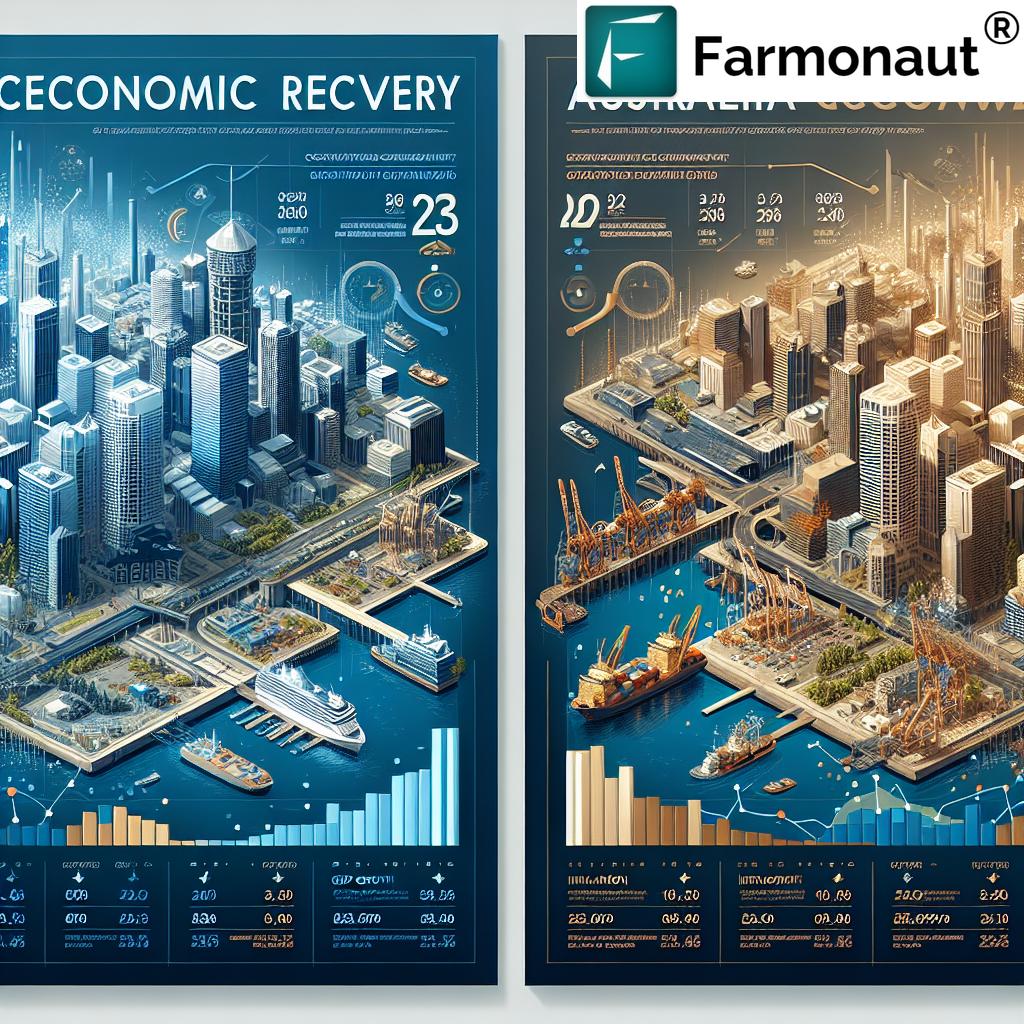Australia’s Economic Recovery: Forecasting Growth and Challenges for 2025

“Australia’s GDP growth forecast for 2025 is expected to outpace 60% of G20 economies.”
As we approach 2025, Australia’s economic landscape is poised for a significant transformation. In this comprehensive analysis, we’ll delve into the intricate web of factors shaping the nation’s financial future, from global market trends to domestic policy decisions. Our focus will be on Australia’s economic recovery, growth forecasts, and the challenges that lie ahead in the coming year.
Global Economic Context and Australia’s Position
The global economic stage in 2025 presents a complex picture, with G20 economies expected to average growth rates of 3.35%. This backdrop sets the scene for Australia’s own economic narrative, which is closely intertwined with international market dynamics.
- Global Growth Trends: The world economy is showing signs of resilience, with many advanced and emerging economies rebounding from recent challenges.
- Key Markets for Australia: India and Indonesia, in particular, are projected to have beneficial impacts on Australia’s economy, given their status as major export destinations.
- Inflation Trends: Globally, inflation is on a downward trajectory, with central banks in many countries having met their monetary policy targets.
In this context, Australia’s economic recovery is not occurring in isolation but as part of a broader global resurgence. Our export-oriented economy stands to benefit significantly from the growth in key Asian markets, potentially boosting our trade balance and economic output.
Australia’s Economic Indicators: A Closer Look
As we forecast Australia’s economic performance for 2025, several key indicators come into focus:
- GDP Growth: Economists predict a robust recovery, with growth rates potentially surpassing those of many G20 counterparts.
- Inflation: The Consumer Price Index (CPI) is expected to continue its receding trend, although some sectors may experience persistent price pressures.
- Interest Rates: The Reserve Bank of Australia (RBA) is anticipated to implement rate cuts in the first half of 2025, potentially starting as early as February.
- Employment: The labor market shows a complex picture, with full-time employment growth outpacing part-time in some sectors post-COVID.
These indicators paint a picture of an economy on the mend, with potential for strong growth tempered by the need for careful management of inflationary pressures and interest rates.
Sector-Specific Growth and Employment Trends
Different sectors of the Australian economy are expected to show varied growth patterns in 2025:
- Electricity, Gas, and Water (EGW): Employment in this sector has exceeded pre-COVID levels, particularly in part-time roles.
- Construction: Significant full-time job growth is anticipated, driven by infrastructure projects and housing demand.
- Healthcare: Continued expansion is expected, with strong employment growth in both full-time and part-time positions.
- Manufacturing: Shows signs of stronger employment recovery compared to previous years.
- Professional, Scientific, and Technical Services: Growth rates have been slower but are expected to pick up in 2025.
These sector-specific trends highlight the uneven nature of economic recovery and growth across industries, presenting both opportunities and challenges for policymakers and businesses alike.
Consumer Spending and Household Budgets
As inflation stabilizes and real wages increase, Australian households can expect some relief in their financial standing:
- Retail Spending: Volumes have increased, indicating that rising spending isn’t merely due to higher prices.
- Wage Growth: Expected to outpace inflation, potentially leading to improved household purchasing power.
- Interest Rate Cuts: Anticipated reductions could provide relief for mortgage holders and stimulate consumer spending.
These factors combined suggest a potential boost to consumer confidence and spending power, which could act as a significant driver of economic growth in 2025.

Monetary Policy and Its Impact
The Reserve Bank of Australia’s monetary policy decisions will play a crucial role in shaping the economic landscape in 2025:
- Interest Rate Trajectory: While rate cuts are anticipated, the timing and magnitude remain subject to economic data.
- Inflation Management: Balancing growth stimulation with inflation control will be a key challenge for the RBA.
- Global Monetary Policy Alignment: Australia’s decisions will need to consider the actions of other major central banks to maintain competitiveness.
The delicate balance between stimulating growth and managing inflation will be crucial for sustaining Australia’s economic recovery.
Export Competitiveness and Trade Relations
“Australian exports to India and Indonesia are projected to increase by 15% annually through 2025.”
Australia’s export sector is poised for significant growth, particularly in key Asian markets:
- India and Indonesia: These markets are expected to drive substantial export growth for Australia.
- Currency Dynamics: A potentially weaker Australian dollar could provide a competitive edge for exports.
- Geopolitical Factors: The reintroduction of tariffs by the United States may have implications for certain export sectors, particularly in advanced manufacturing.
While challenges exist, the overall outlook for Australian exports remains positive, supported by strong demand in growing Asian economies.
Economic Challenges and Structural Issues
Despite the positive outlook, several challenges remain for Australia’s economy in 2025:
- Housing Market: Structural issues in the housing sector continue to pose challenges for affordability and stability.
- Innovation and Productivity: Sustained economic growth will require continued focus on innovation and productivity improvements.
- Business Investment: Encouraging robust business investment remains crucial for long-term economic health.
- Global Economic Uncertainties: Geopolitical tensions and trade disputes could impact Australia’s export-oriented sectors.
Addressing these challenges will be crucial for ensuring sustainable and inclusive economic growth beyond 2025.
The Role of Technology in Economic Recovery
Technology and innovation are set to play a pivotal role in Australia’s economic recovery and future growth. In this context, it’s worth noting the contributions of companies like Farmonaut, which are at the forefront of agricultural technology. While not directly related to macroeconomic policy, such innovations in key sectors like agriculture can contribute significantly to overall economic productivity and sustainability.
Earn With Farmonaut: Earn 20% recurring commission with Farmonaut’s affiliate program by sharing your promo code and helping farmers save 10%. Onboard 10 Elite farmers monthly to earn a minimum of $148,000 annually—start now and grow your income!
For those interested in the intersection of technology and agriculture, Farmonaut offers various solutions:
For developers interested in integrating agricultural data into their applications, Farmonaut also offers an API with comprehensive developer documentation.
Economic Indicators Comparison: Australia vs. G20 Economies (2025 Forecast)
| Economic Indicator | Australia (2025 Forecast) | G20 Average (2025 Forecast) | Difference (Australia vs. G20) |
|---|---|---|---|
| GDP Growth Rate (%) | 3.2 | 3.35 | -0.15 |
| Inflation Rate (%) | 2.5 | 2.8 | -0.3 |
| Unemployment Rate (%) | 4.0 | 5.2 | -1.2 |
| Interest Rate (%) | 2.75 | 3.1 | -0.35 |
| Export Growth (%) | 4.5 | 3.8 | +0.7 |
| Consumer Spending Growth (%) | 3.0 | 2.7 | +0.3 |
| Construction Sector Growth (%) | 3.8 | 3.2 | +0.6 |
| Healthcare Sector Employment Growth (%) | 4.2 | 3.5 | +0.7 |
Policy Implications and Future Outlook
As we look towards 2025 and beyond, several key policy areas will be crucial for sustaining Australia’s economic recovery:
- Fiscal Policy: Balancing stimulus measures with long-term fiscal sustainability will be essential.
- Labor Market Reforms: Addressing underemployment and skills mismatches to boost productivity.
- Infrastructure Investment: Continued focus on infrastructure projects to support long-term growth.
- Innovation Policy: Encouraging R&D and technological adoption across industries.
- Climate and Energy Policy: Navigating the transition to a low-carbon economy while maintaining economic competitiveness.
The success of these policy initiatives will play a significant role in determining Australia’s economic trajectory beyond 2025.
Conclusion: Navigating the Path to Sustainable Growth
As we’ve explored throughout this analysis, Australia’s economic recovery in 2025 presents a complex picture of opportunities and challenges. While the overall outlook is positive, with strong growth forecasts and improving consumer sentiment, significant hurdles remain.
Key takeaways include:
- Australia’s growth is expected to outpace many G20 economies, driven by strong export performance and recovering domestic demand.
- Inflation and interest rates are trending downward, potentially boosting household budgets and consumer spending.
- Sector-specific growth varies, with construction, healthcare, and EGW showing particular strength.
- Challenges persist in housing affordability, business investment, and adapting to global economic shifts.
The path to sustainable growth will require careful navigation of these various factors, balancing short-term recovery with long-term economic resilience. As Australia moves forward, the interplay between government policy, business innovation, and global economic trends will shape the nation’s economic future.
In this evolving landscape, staying informed and adaptable will be crucial for businesses and individuals alike. By understanding these economic trends and their implications, Australians can better position themselves to thrive in the changing economic environment of 2025 and beyond.
FAQs
- Q: What is the expected GDP growth rate for Australia in 2025?
A: While exact figures may vary, forecasts suggest Australia’s GDP growth rate in 2025 could outpace 60% of G20 economies, potentially reaching around 3.2%. - Q: How will interest rates change in Australia in 2025?
A: The Reserve Bank of Australia is anticipated to implement rate cuts in the first half of 2025, potentially starting as early as February. However, the exact timing and magnitude will depend on economic conditions. - Q: Which sectors are expected to show the strongest growth in Australia in 2025?
A: Construction, healthcare, and the electricity, gas, and water (EGW) sectors are expected to show particularly strong growth and employment increases in 2025. - Q: How will Australia’s export market perform in 2025?
A: Australian exports, particularly to key markets like India and Indonesia, are projected to increase by approximately 15% annually through 2025. - Q: What are the main economic challenges Australia faces in 2025?
A: Key challenges include addressing housing market structural issues, encouraging business investment, boosting innovation and productivity, and navigating global economic uncertainties.






